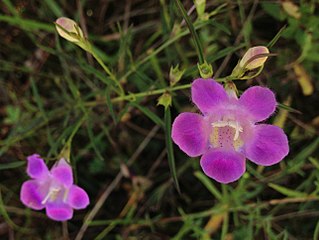
Boraginaceae, the borage or forget-me-notfamily, includes about 2,000 species of shrubs, trees and herbs in 146, to 156 genera with a worldwide distribution.

Hydrophylloideae is a subfamily of the plant family Boraginaceae. Their taxonomic position is somewhat uncertain. Traditionally, and under the Cronquist system, they were given family rank under the name Hydrophyllaceae, and treated as part of the order Solanales. More recent systems have recognised their close relationship to the borage family, Boraginaceae, initially by placing Hydrophyllaceae and Boraginaceae together in an order Boraginales, and most recently by demoting Hydrophyllaceae to a subfamily of Boraginaceae. However the placement and circumscription of Boraginaceae is still uncertain: it is unplaced at order level, and there is some prospect of it being split up again in future.

Phacelia crenulata is a species of flowering plant in the borage family, Boraginaceae. Its common names include notch-leaf scorpion-weed, notch-leaved phacelia, cleftleaf wildheliotrope, and heliotrope phacelia. Phacelia crenulata has an antitropical distribution, a type of disjunct distribution where a species exists at comparable latitudes on opposite sides of the equator, but not at the tropics. In North America, it is native to the southwestern United States as far east as Colorado and New Mexico, and Baja California and Sonora in Mexico. In South America, it is native to southern Peru, western Bolivia, and northern Chile.

Phacelia is a genus of about 200 species of annual or perennial herbaceous plants in the borage family, native to North and South America. California is particularly rich in species with over 90 recorded in the region.

Phacelia purshii, known by the common names Miami mist, scorpionweed, and purple scorpionweed, is a spring flowering annual forb with blue, lavender, violet, or nearly white flowers in the Boraginaceae (borage) family that is native to eastern and central North America.

Phacelia distans is a species of flowering plant in the borage family, Boraginaceae, known by the common names distant phacelia and distant scorpionweed. It is native to the southwestern United States and northwestern Mexico, where it grows in many types of habitat, including forest, woodland, chaparral, grassland, and meadows.

Phacelia hastata is a species of flowering plant in the borage family, Boraginaceae. Its common names include silverleaf scorpionweed, silverleaf phacelia, and white-leaf phacelia. It is native to western North America from British Columbia and Alberta south to California and east to Nebraska. It can be found in many types of habitat, including scrub, woodland, and forest, up to an elevation of 13,000 feet. It prefers sandy to rocky soil.

Phacelia ivesiana is a species of flowering plant in the borage family, Boraginaceae. Its common names include Ives' phacelia and Ives' scorpionweed. It is divided into varieties that have been called sticky scorpionweed. It is native to the western United States.

Phacelia pedicellata is a species of flowering plant in the borage family, Boraginaceae. Its common names include specter phacelia and pedicellate phacelia. It is native to the southwestern United States and Baja California, where it can be found in several types of habitat, including creosote bush scrub and Joshua tree woodland.

Phacelia tanacetifolia is a species of flowering plant in the borage family Boraginaceae, known by the common names lacy phacelia, blue tansy or purple tansy.

Phacelia dubia is an annual forb native to the eastern United States, that produces cream colored or light blue flowers in early spring.

Sericocarpus linifolius, the narrowleaf whitetop aster or flax leaf whitetop, is a perennial forb native to the eastern United States, that produces white composite flowers in summer.

Cardamine angustata is a perennial forb native to the eastern United States, that produces white to pink or purple flowers in early spring.

Cardamine douglassii, the limestone bittercress or purple cress, is a perennial forb native to the eastern and central United States as well as the province of Ontario in Canada, that produces white to pink or purple flowers in early spring.

Uvularia perfoliata, the perfoliate bellwort, is a perennial forb native to the eastern United States and Canada, which produces pale yellow flowers in spring.

Aureolaria virginica, the downy yellow false foxglove or downy oak leach, is a perennial forb native to the eastern United States and Canada, which produces yellow flowers in summer.

Agalinis purpurea is an annual forb native to the eastern United States and Canada, which produces purple flowers in late summer or early fall.

Agalinis tenuifolia, known by the common names common gerardia, slender false foxglove or common false foxglove, is an annual forb native to the eastern and southwestern United States, and Canada, which produces purple flowers in late summer or early fall.

Clitoria mariana, known by the common names butterfly pea and Atlantic pigeon wings, is a perennial herbaceous plant in the pea family, Fabaceae. The plant is native to the United States.

Phacelia ranunculacea, the oceanblue phacelia or western buttercup phacelia, is a North American species of annual forbs in the borage family. It is native to a small area of the eastern United States in the valleys of the Mississippi River and lower Ohio River. In this region, it is found in bottomland and floodplain forests. It produces a pale blue flower in early spring.























